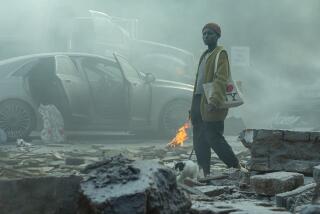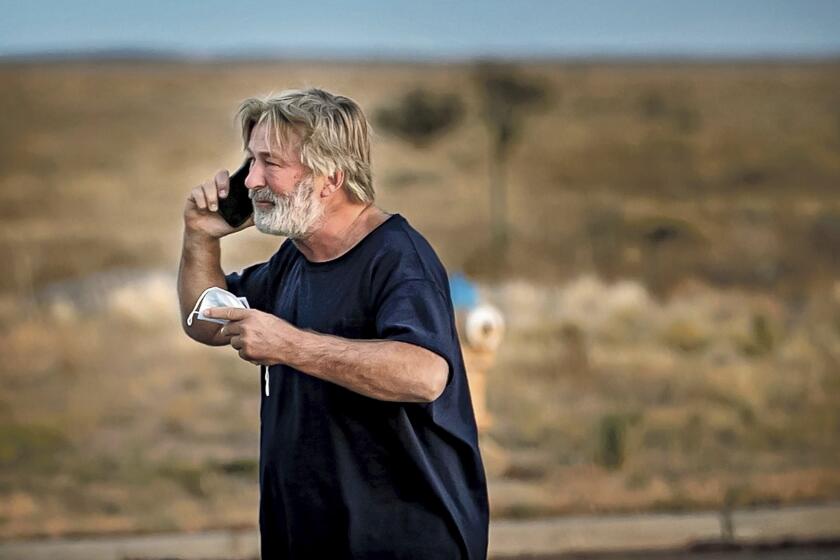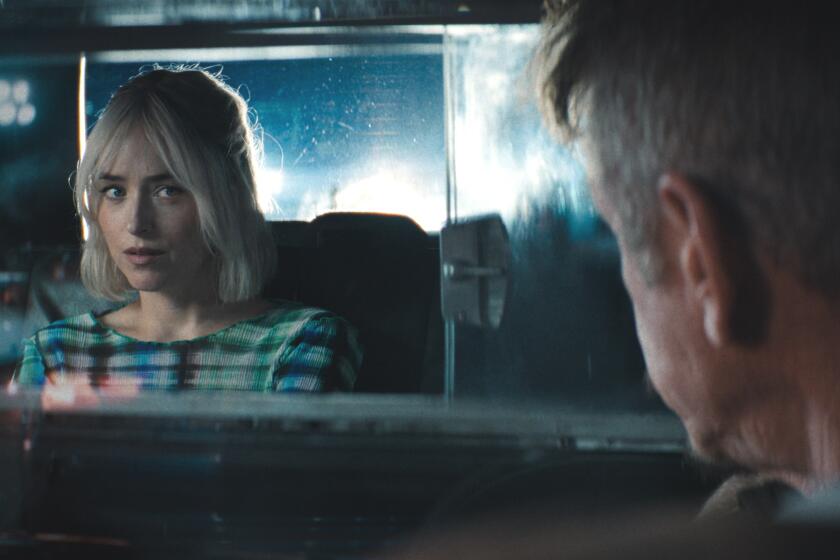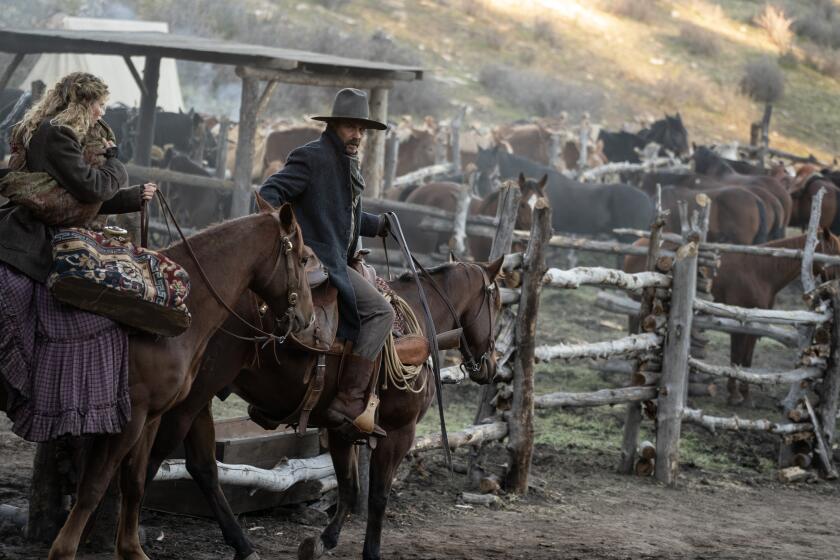MOVIES : Corruption, Heroism and America : German director Wolfgang Petersen set out to distill the essence of our country and its heroes and villains in a political assassin thriller
“The question of who the heroes and villains are today is extremely complicated,” says director Wolfgang Petersen of “In the Line of Fire,” the political thriller opening Friday that stars John Malkovich as an assassin and Clint Eastwood as the Secret Service agent tracking him. “On one level John Malkovich’s character is clearly the villain of this story because you shouldn’t do the reprehensible things he does, but on a deeper level--and this is what makes the film interesting--this is not a black-and-white situation, and John’s character has good reasons for what he does.
“The film is a real indictment of Washington, and when John’s character says, ‘Nothing they told me was true and there’s nothing left worth fighting for,’ I think his words will resonate for many people,” Petersen continues during an interview in the Culver City offices of Radient Productions, his company which signed a non-exclusive, first look deal with TriStar in 1991.
“The film is rooted in a profound pessimism about what’s unfortunately happened to this country in the last 30 years. Look around--the corruption is everywhere, and there’s not much to celebrate. If you go see the Lincoln Memorial today, you get a very funny feeling because there are no Lincolns around anymore.”
With Clint Eastwood hot off of “Unforgiven,” one of the most critically acclaimed films of his career, “In the Line of Fire” should do good box office from the gate. But anyone who goes expecting a straight-shooting action picture is in for a surprise because this film, which also stars Rene Russo and Dylan McDermott and is based on a screenplay by Jeff McGuire, aims for a lot more.
For starters, Eastwood’s character, a morose, alcoholic Secret Service agent, is a loser of sorts, and we’re not used to seeing one of the biggest heroes of American popular culture that way. Moreover, the politics of the picture are complicated by the fact that the President he is assigned to protect is such a corrupt and empty cardboard cut-out figure that he hardly seems worth Eastwood’s time.
The plot thickens even more by virtue of the fact that Malkovich’s character--ostensibly the psychopath of the story--has frequent passages of dialogue where he rails about how he, along with the entire country, have been sold down the river by anonymous fat cats in Washington, and the things he says make a lot of sense. Midway through the film, one is apt to feel completely confused as to whom to root for.
“The villain in this story is the general public, which, if you’ll excuse me, is intensely stupid,” says Malkovich, whose character assumes a series of identities as the story unfolds. “They get the world and the leaders they deserve.
“I would also add that if you take a decent person--and one might quibble over whether decent people go into politics . . . I don’t have an answer for that--but take a decent person and constantly revile them, and try and uncover anything they might’ve done wrong, then put it on ‘Geraldo,’ and my guess is this will not be conducive to great behavior. If you expect the best from people and let them know you expect the best in a way that’s humane, you’ll probably get something a little better than what we get.”
Made for $39 million on locations in Washington, D.C., and Los Angeles during a 16-week shoot that began last October, “In the Line of Fire” is the first film made with the full cooperation of the Secret Service.
“They didn’t agree to help us because they thought the film would portray them in a heroic light--Clint plays a pretty flawed character, and John’s character makes some very negative points about the Secret Service,” says the 52-year-old director, whose 1981 film about a doomed German submarine in World War II, “Das Boot,” won him international acclaim. “I think the Secret Service was interested in the possibility of their world being accurately portrayed in a Hollywood film for the first time. They didn’t want us to make a commercial for them, they just wanted it to be real, and though they had no creative control, they made many suggestions we happily accepted.
“I was thrilled to get to talk to these people too, because I’ve always been fascinated by the Secret Service,” continues Petersen, an affable man who, unlike many European directors, seems completely at ease working within the constraints of the American film industry. “This is a very elite group--worldwide there are only about 2,000 agents--and I’m mystified by what motivates these people to take on this work. Speaking as a German, it strikes me as a peculiarly American kind of heroism.
“These people are trained that as soon as they hear a gun go off they’re supposed to open themselves up and take the bullet intended for the person they’re protecting. It’s very strange because it goes against human instinct, and you can’t dismiss it as a macho thing because it’s not about aggression--it’s a defensive behavior, and the goal is to be a human shield and take the bullet. Clint and I often discussed whether we could imagine doing this and neither of us could.”
“One of the reasons I was interested in this part is because I wanted to understand the kind of guy who would take a bullet for another person he might not even know or like,” says Eastwood. “That’s an interesting guy.”
Eastwood’s character, Frank Horrigan, is loosely based on Clint Hill, the Secret Service agent who climbed up on the back of the limousine in Dallas when Kennedy was shot; Kennedy, in fact, is a palpable presence in the story, which pivots on him as a symbol of a lost golden age in America.
Asked if the fact that the Kennedy myth has been all but dismantled by the media in recent years presented a problem in terms of the basic premise of the film, Petersen concedes that “yes, the Kennedy myth has been tarnished, but he’s still a potent symbol of a devastating loss this country has experienced in terms of hope about the future and trust between the people and their leaders.
“From that peak moment of Kennedy saying, ‘Ich Bin Ein Berliner,’ to Vietnam, to Watergate, to Contragate, there’s obviously been a steady decline. But this isn’t just happening in America--we have the same situation in Europe,” adds Petersen, who moved from Germany to Los Angeles in 1987, and now lives in Santa Monica. “There are no more great political leaders like Willy Brandt, Churchill and De Gaulle, and there are no more Truffauts, Bergmans or Fellinis either. We’ve clearly lost something.”
One wonders whether the current low level of leadership may have to do with the fact that the media has distorted public understanding of what constitutes great statesmanship. The fact that Clint Eastwood--a man of tremendous integrity, but a filmmaker nonetheless--could probably be elected President suggests that media and politics have almost become one and the same thing.
“Yes, I’m sure the media does play a big role in this state of affairs and it’s true Clint could probably be elected President. When we were shooting on location in Washington, we were constantly surrounded by huge crowds screaming, ‘Clint for President,’ and the reason for that is simple, and it goes way beyond his being a good actor; people trust Clint Eastwood. You know that what you see is what you get with him, that he’s an honest, down-to-earth man, and that he stands up for what he believes in--and those qualities are rare,” says Petersen, who’s clearly somewhat in awe of the 63-year-old star.
Having grown up with a head full of dreams about the United States that were largely shaped by American movies, it’s not surprising that Petersen is a huge fan of Eastwood’s. Though he cites Truffaut as his most important influence, he concedes that “there’s nothing German, or even particularly European about my films,” and that for him, movies are essentially an American art form.
“I was born in 1941, and growing up in Germany after the war was pretty bad--my family was poor as was everyone else, we lived in wooden barracks, and there was very little food available,” he recalls. “I lived in Emden, which is a small port city in the north, and whenever American ships came into the harbor all us kids would run alongside them and the Americans would throw food down to us. Sometimes they invited us onto the ship and we’d have a meal with them--it was as if they came from another planet where everybody was rich and generous and had plenty to eat.
“In school they never talked about the time of Hitler--they just blocked it out of their minds and concentrated on rebuilding Germany,” he continues. “We kids were looking for more glamorous dreams than rebuilding a destroyed country though, so we were really ready for it when American pop culture came to Germany. We all lived for American movies, and by the time I was 11 I’d decided I wanted to be a filmmaker. I spent all my time in the library looking for books on the subject--I was obsessed when I was a teen-ager.”
Citing John Ford as the first filmmaker to make a deep impression on him--”I was probably drawn to those films because good and evil were so clearly drawn in them, and Europe was so messy at that point”--Petersen went on to immerse himself in the directors of the French Nouvelle Vague (Truffaut in particular), and in the work of such young Eastern European filmmakers as Roman Polanski and Jerry Skolminowski.
Beginning his career at the age of 19 as an assistant stage director at Hamburg’s Ernst Deutsch Theater, Petersen directed his first play in 1961, then spent the next two years studying acting at private schools in Hamburg and Berlin.
After four years of film school in which he studied acting in Berlin, Petersen began directing for German television in 1970, then three years later released his first feature film, “One of Us Two.” The story of a German student who blackmails one of his professors, the film was made for less than a million dollars.
Five years later he released his second film, a controversial homosexual love story titled “The Consequence,” which was banned in parts of Germany, and the following year completed “Black and White Like Night and Day,” a thriller set in the world of championship chess starring Bruno Ganz.
With the success of “Das Boot” in 1981, Petersen’s budgets and his clout began to go up and he started to slowly move his career to America. In 1984, he completed the cinematic fairy tale “The Neverending Story,” which was followed by the 1985 sci-fi fantasy starring Dennis Quaid and Louis Gossett Jr., “Enemy Mine,” and the 1991 noir thriller starring Tom Berenger, “Shattered.”
Though “The Neverending Story” grossed $119 million worldwide (and was made for just $27 million), and “Enemy Mine” was a modest commercial hit in Europe, it wasn’t Petersen’s box-office track record that landed him “In the Line of Fire”; he got the film because Eastwood had seen and liked “Das Boot” and “Shattered,” and wanted him for the project.
“I was very impressed by “Das Boot” and “Shattered,” says Eastwood, “and I was also interested in getting a European perspective on the Secret Service. And when I met with Wolfgang it was immediately clear that we were in agreement about how the film should be made,” he said in explaining why he thought Petersen was right for the job.
“I must admit, I was initially a bit intimidated at the prospect of directing Clint, but any fears I had disappeared after our first meeting, and once we started shooting he never challenged my direction,” says Petersen of Eastwood. “At the beginning he told me, ‘I won’t interfere, but if you want my advice I’ll be there for you--otherwise I’ll leave you alone.’ I took up his offer and consulted him a lot.
“Malkovich was great to work with as well,” Petersen continues. “I anticipated a very serious Method actor who’d want to discuss everything with me at length, but he wasn’t like that at all. As an actor he seems to rely almost entirely on instinct, and he’s a very funny man who’s often silly like a kid--I sometimes felt he never even thought about his part because he was so easy on the set.”
Malkovich confirms Petersen’s feeling when he comments that “the hardest thing about this part was all the running I had to do--I hate running and don’t intend to do it again for a long time. I didn’t train for the running scenes either--I just put down my cigarettes for a minute and ran.”
It’s fortunate for Petersen that his cast was so cooperative because the film presented huge logistic challenges. “Those problems presented themselves the first day of shooting too--the first scene we shot was a huge motorcade in Washington, D.C.,” Petersen recalls.
“Closing down Pennsylvania Avenue during the day is a pretty big thing and you need good connections to pull that off. The Bush White House didn’t want any part of a filmmaking project, but the Secret Service did help us. For that scene we had to create a motorcade of 50 vehicles, we built our own presidential limo--there’s only one and they wouldn’t loan it--and we had to get thousands of extras on the street. On top of that, we had to deal with the thousands of people who came to watch us and never stopped screaming, ‘Clint for President.’ ”
The production saved immeasurable time and money by using cutting-edge computer technology to shoot many big crowd scenes. “It was our great luck to go into production right when the 1992 presidential campaign was in high gear, and we shot a lot of footage at actual rallies,” says Petersen.
“Because the Secret Service was helping us, we got amazing camera positions, then with digital computer techniques we’d erase whoever was actually speaking at the rally and insert our fictional President instead. The computer also had to alter all the names on the placards, so it was a lot of work to clean these shots up, but still, this technique was a tremendous asset. This technology has been used in television commercials, but this is the first time it’s been used in a feature film.
“This is a very big-scale film--probably the biggest I’ve done--but the core of the story is the relationship between Clint and John’s characters,” he concludes. “They’re engaged in an existential duel evocative of Faust and Mephisto, and that is the focus of the film.
“I’ve always aspired to work in the manner of David Lean, who had a great talent for combining the excitement of a large-scale visual experience, with very concentrated, intimate character studies,” he adds. “I’m not interested in wall-to-wall action--I want to be touched and moved--but that doesn’t mean the characters have to sit in the kitchen all the time and talk. This is, after all, a visual medium.”
Having worked in America for six years, Petersen says it’s difficult for him to imagine returning to Germany to make films--”the level of professionalism is just so much higher here,” he points out. “In Germany, when the first shooting break comes at 9:30 in the morning everybody insists on having a couple of beers! What’s more, the European filmmaking community is in a very sad state right now, and the people of talent there come to America to work. If you’re obsessed with filmmaking, you go where you must in order to work. America’s political system may be on its last legs, but it’s still easier to make a movie here.”
More to Read
Only good movies
Get the Indie Focus newsletter, Mark Olsen's weekly guide to the world of cinema.
You may occasionally receive promotional content from the Los Angeles Times.






